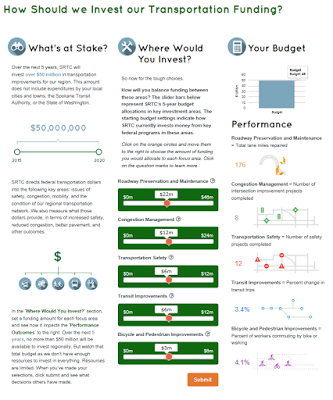You’ve got a couple more weeks to let us know how you would spend $50 million on local transportation if it was your choice. SRTC webtool let’s you weight in about your transportation priorities by basically voting with your (imaginary) dollars.
New federal and state regulations require Metropolitan Planning
Organizations like SRTC to create and track performance measures and targets to
ensure the transportation system is developing as planned. This is being done
through a project called the Horizon 2040
Implementation Toolkit.
Organizations like SRTC to create and track performance measures and targets to
ensure the transportation system is developing as planned. This is being done
through a project called the Horizon 2040
Implementation Toolkit.
Horizon 2040 is the region’s long-term transportation plan that guides how our
transportation system will grow between today and the year 2040. The Horizon
2040 Implementation Toolkit will identify measures and targets that can be measured
using available data that relate to Horizon 2040’s Guiding Principles.
The web tool
will help you understand how investments and outcomes are related and also
allows you to identify priorities of the region that will help develop those
targets. The tool allows users to choose an estimated level at which they would
like to fund categories such as roadway preservation and management, congestion
management, bicycle and pedestrian improvements, transit improvements and
transportation safety.
will help you understand how investments and outcomes are related and also
allows you to identify priorities of the region that will help develop those
targets. The tool allows users to choose an estimated level at which they would
like to fund categories such as roadway preservation and management, congestion
management, bicycle and pedestrian improvements, transit improvements and
transportation safety.
As you
allocate money to each category, graphics show just how far that amount would
go. For instance, for roadway preservation, the amount of lane miles repaired
changes as you change the funding for that category. For bicycle and pedestrian
improvements, the percentage of people commuting by bike or walking increases
or decreases as you add or subtract money. Screen shots on the following page
give an idea what you will see when using the web tool.
allocate money to each category, graphics show just how far that amount would
go. For instance, for roadway preservation, the amount of lane miles repaired
changes as you change the funding for that category. For bicycle and pedestrian
improvements, the percentage of people commuting by bike or walking increases
or decreases as you add or subtract money. Screen shots on the following page
give an idea what you will see when using the web tool.
Just like in
real life, the hard part is not blowing your budget. The $50 million available
for distribution on the web tool is based on the approximate amount of money
projected to be invested in the local transportation system by SRTC over the
next five years. Once you have made your
budgeting decisions, you can compare your results to others who have used the
web tool and learn about the next steps in the performance measurements
development process.
real life, the hard part is not blowing your budget. The $50 million available
for distribution on the web tool is based on the approximate amount of money
projected to be invested in the local transportation system by SRTC over the
next five years. Once you have made your
budgeting decisions, you can compare your results to others who have used the
web tool and learn about the next steps in the performance measurements
development process.

